Analyzing Communication Skills: Identifying Issues and Developing an Action Plan for Effective Business Communication
VerifiedAdded on 2023/06/12
|13
|4520
|460
AI Summary
A reflective essay that analyzes the author's communication skills using five diagnostic tools and identifies two issues - intercultural communication apprehension and tolerance for disagreement. The author discusses these issues in detail with the help of literature review and presents an action plan to overcome them.
Contribute Materials
Your contribution can guide someone’s learning journey. Share your
documents today.
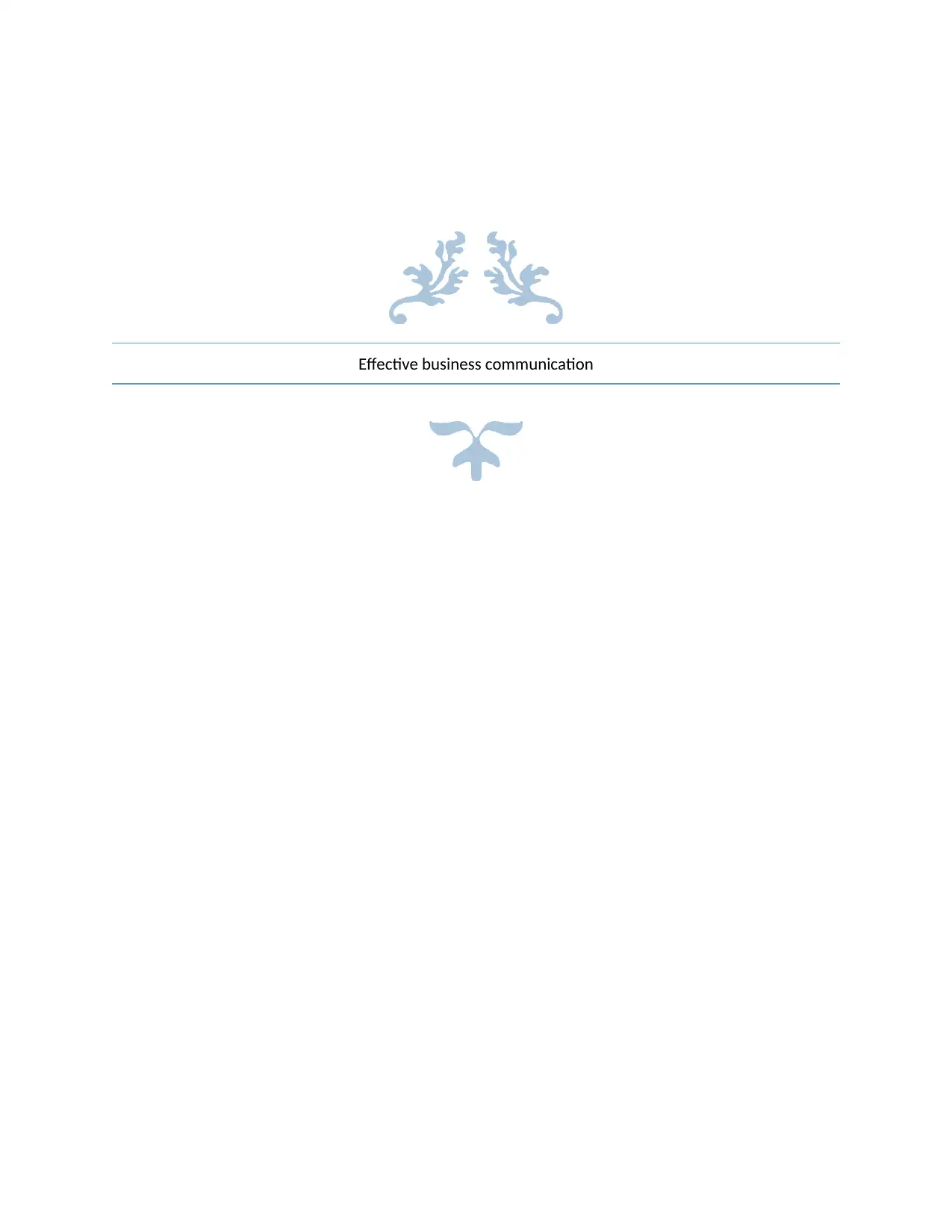
Effective business communication
Secure Best Marks with AI Grader
Need help grading? Try our AI Grader for instant feedback on your assignments.
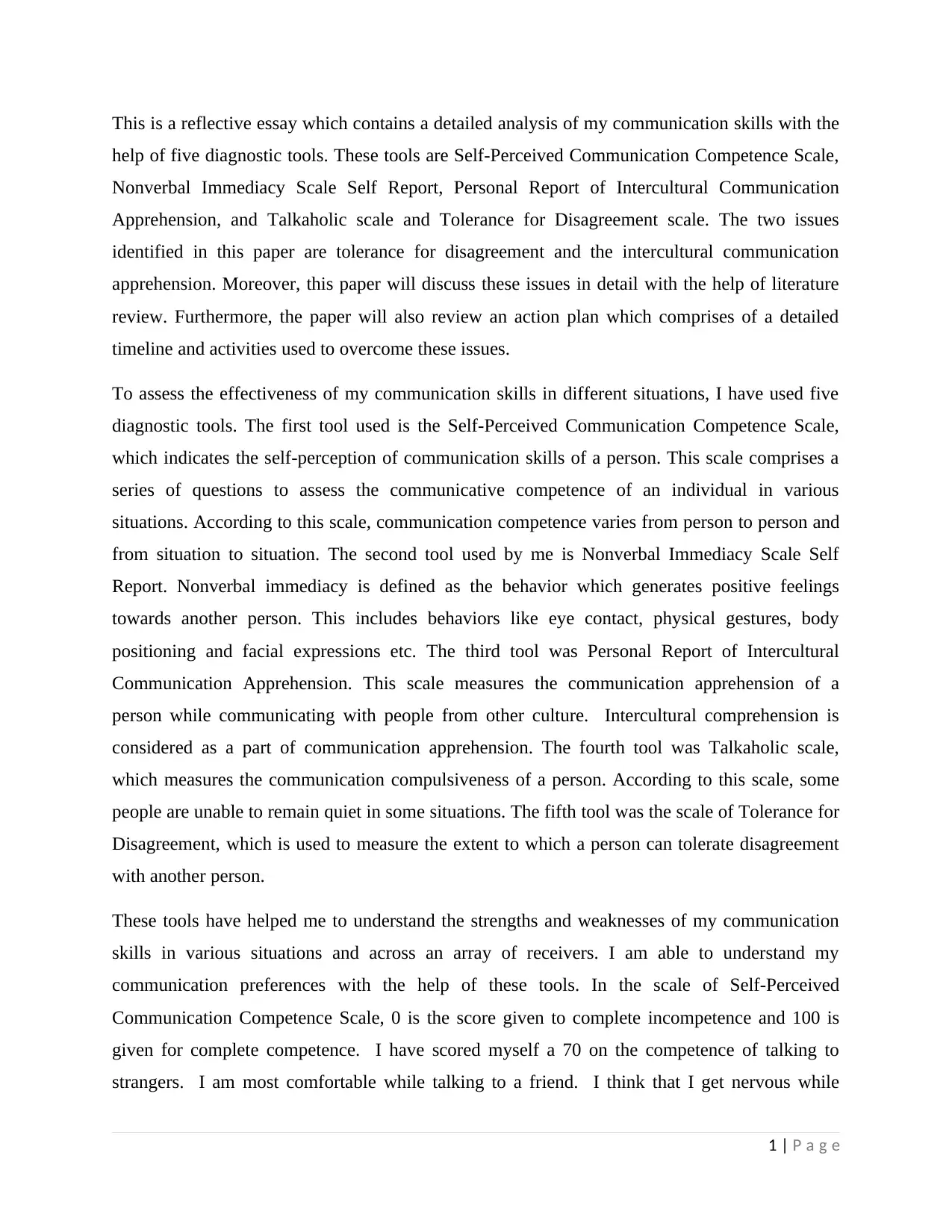
This is a reflective essay which contains a detailed analysis of my communication skills with the
help of five diagnostic tools. These tools are Self-Perceived Communication Competence Scale,
Nonverbal Immediacy Scale Self Report, Personal Report of Intercultural Communication
Apprehension, and Talkaholic scale and Tolerance for Disagreement scale. The two issues
identified in this paper are tolerance for disagreement and the intercultural communication
apprehension. Moreover, this paper will discuss these issues in detail with the help of literature
review. Furthermore, the paper will also review an action plan which comprises of a detailed
timeline and activities used to overcome these issues.
To assess the effectiveness of my communication skills in different situations, I have used five
diagnostic tools. The first tool used is the Self-Perceived Communication Competence Scale,
which indicates the self-perception of communication skills of a person. This scale comprises a
series of questions to assess the communicative competence of an individual in various
situations. According to this scale, communication competence varies from person to person and
from situation to situation. The second tool used by me is Nonverbal Immediacy Scale Self
Report. Nonverbal immediacy is defined as the behavior which generates positive feelings
towards another person. This includes behaviors like eye contact, physical gestures, body
positioning and facial expressions etc. The third tool was Personal Report of Intercultural
Communication Apprehension. This scale measures the communication apprehension of a
person while communicating with people from other culture. Intercultural comprehension is
considered as a part of communication apprehension. The fourth tool was Talkaholic scale,
which measures the communication compulsiveness of a person. According to this scale, some
people are unable to remain quiet in some situations. The fifth tool was the scale of Tolerance for
Disagreement, which is used to measure the extent to which a person can tolerate disagreement
with another person.
These tools have helped me to understand the strengths and weaknesses of my communication
skills in various situations and across an array of receivers. I am able to understand my
communication preferences with the help of these tools. In the scale of Self-Perceived
Communication Competence Scale, 0 is the score given to complete incompetence and 100 is
given for complete competence. I have scored myself a 70 on the competence of talking to
strangers. I am most comfortable while talking to a friend. I think that I get nervous while
1 | P a g e
help of five diagnostic tools. These tools are Self-Perceived Communication Competence Scale,
Nonverbal Immediacy Scale Self Report, Personal Report of Intercultural Communication
Apprehension, and Talkaholic scale and Tolerance for Disagreement scale. The two issues
identified in this paper are tolerance for disagreement and the intercultural communication
apprehension. Moreover, this paper will discuss these issues in detail with the help of literature
review. Furthermore, the paper will also review an action plan which comprises of a detailed
timeline and activities used to overcome these issues.
To assess the effectiveness of my communication skills in different situations, I have used five
diagnostic tools. The first tool used is the Self-Perceived Communication Competence Scale,
which indicates the self-perception of communication skills of a person. This scale comprises a
series of questions to assess the communicative competence of an individual in various
situations. According to this scale, communication competence varies from person to person and
from situation to situation. The second tool used by me is Nonverbal Immediacy Scale Self
Report. Nonverbal immediacy is defined as the behavior which generates positive feelings
towards another person. This includes behaviors like eye contact, physical gestures, body
positioning and facial expressions etc. The third tool was Personal Report of Intercultural
Communication Apprehension. This scale measures the communication apprehension of a
person while communicating with people from other culture. Intercultural comprehension is
considered as a part of communication apprehension. The fourth tool was Talkaholic scale,
which measures the communication compulsiveness of a person. According to this scale, some
people are unable to remain quiet in some situations. The fifth tool was the scale of Tolerance for
Disagreement, which is used to measure the extent to which a person can tolerate disagreement
with another person.
These tools have helped me to understand the strengths and weaknesses of my communication
skills in various situations and across an array of receivers. I am able to understand my
communication preferences with the help of these tools. In the scale of Self-Perceived
Communication Competence Scale, 0 is the score given to complete incompetence and 100 is
given for complete competence. I have scored myself a 70 on the competence of talking to
strangers. I am most comfortable while talking to a friend. I think that I get nervous while
1 | P a g e
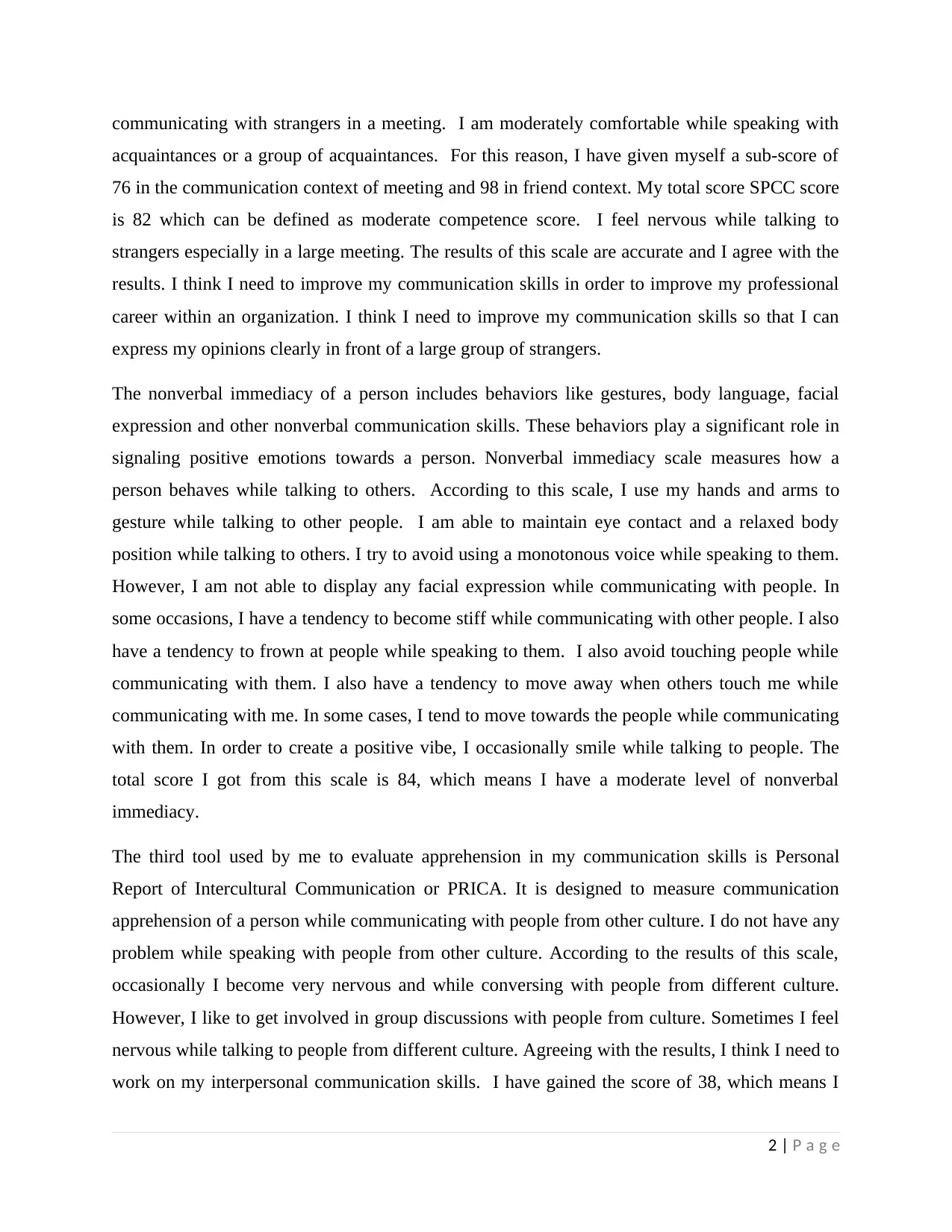
communicating with strangers in a meeting. I am moderately comfortable while speaking with
acquaintances or a group of acquaintances. For this reason, I have given myself a sub-score of
76 in the communication context of meeting and 98 in friend context. My total score SPCC score
is 82 which can be defined as moderate competence score. I feel nervous while talking to
strangers especially in a large meeting. The results of this scale are accurate and I agree with the
results. I think I need to improve my communication skills in order to improve my professional
career within an organization. I think I need to improve my communication skills so that I can
express my opinions clearly in front of a large group of strangers.
The nonverbal immediacy of a person includes behaviors like gestures, body language, facial
expression and other nonverbal communication skills. These behaviors play a significant role in
signaling positive emotions towards a person. Nonverbal immediacy scale measures how a
person behaves while talking to others. According to this scale, I use my hands and arms to
gesture while talking to other people. I am able to maintain eye contact and a relaxed body
position while talking to others. I try to avoid using a monotonous voice while speaking to them.
However, I am not able to display any facial expression while communicating with people. In
some occasions, I have a tendency to become stiff while communicating with other people. I also
have a tendency to frown at people while speaking to them. I also avoid touching people while
communicating with them. I also have a tendency to move away when others touch me while
communicating with me. In some cases, I tend to move towards the people while communicating
with them. In order to create a positive vibe, I occasionally smile while talking to people. The
total score I got from this scale is 84, which means I have a moderate level of nonverbal
immediacy.
The third tool used by me to evaluate apprehension in my communication skills is Personal
Report of Intercultural Communication or PRICA. It is designed to measure communication
apprehension of a person while communicating with people from other culture. I do not have any
problem while speaking with people from other culture. According to the results of this scale,
occasionally I become very nervous and while conversing with people from different culture.
However, I like to get involved in group discussions with people from culture. Sometimes I feel
nervous while talking to people from different culture. Agreeing with the results, I think I need to
work on my interpersonal communication skills. I have gained the score of 38, which means I
2 | P a g e
acquaintances or a group of acquaintances. For this reason, I have given myself a sub-score of
76 in the communication context of meeting and 98 in friend context. My total score SPCC score
is 82 which can be defined as moderate competence score. I feel nervous while talking to
strangers especially in a large meeting. The results of this scale are accurate and I agree with the
results. I think I need to improve my communication skills in order to improve my professional
career within an organization. I think I need to improve my communication skills so that I can
express my opinions clearly in front of a large group of strangers.
The nonverbal immediacy of a person includes behaviors like gestures, body language, facial
expression and other nonverbal communication skills. These behaviors play a significant role in
signaling positive emotions towards a person. Nonverbal immediacy scale measures how a
person behaves while talking to others. According to this scale, I use my hands and arms to
gesture while talking to other people. I am able to maintain eye contact and a relaxed body
position while talking to others. I try to avoid using a monotonous voice while speaking to them.
However, I am not able to display any facial expression while communicating with people. In
some occasions, I have a tendency to become stiff while communicating with other people. I also
have a tendency to frown at people while speaking to them. I also avoid touching people while
communicating with them. I also have a tendency to move away when others touch me while
communicating with me. In some cases, I tend to move towards the people while communicating
with them. In order to create a positive vibe, I occasionally smile while talking to people. The
total score I got from this scale is 84, which means I have a moderate level of nonverbal
immediacy.
The third tool used by me to evaluate apprehension in my communication skills is Personal
Report of Intercultural Communication or PRICA. It is designed to measure communication
apprehension of a person while communicating with people from other culture. I do not have any
problem while speaking with people from other culture. According to the results of this scale,
occasionally I become very nervous and while conversing with people from different culture.
However, I like to get involved in group discussions with people from culture. Sometimes I feel
nervous while talking to people from different culture. Agreeing with the results, I think I need to
work on my interpersonal communication skills. I have gained the score of 38, which means I
2 | P a g e
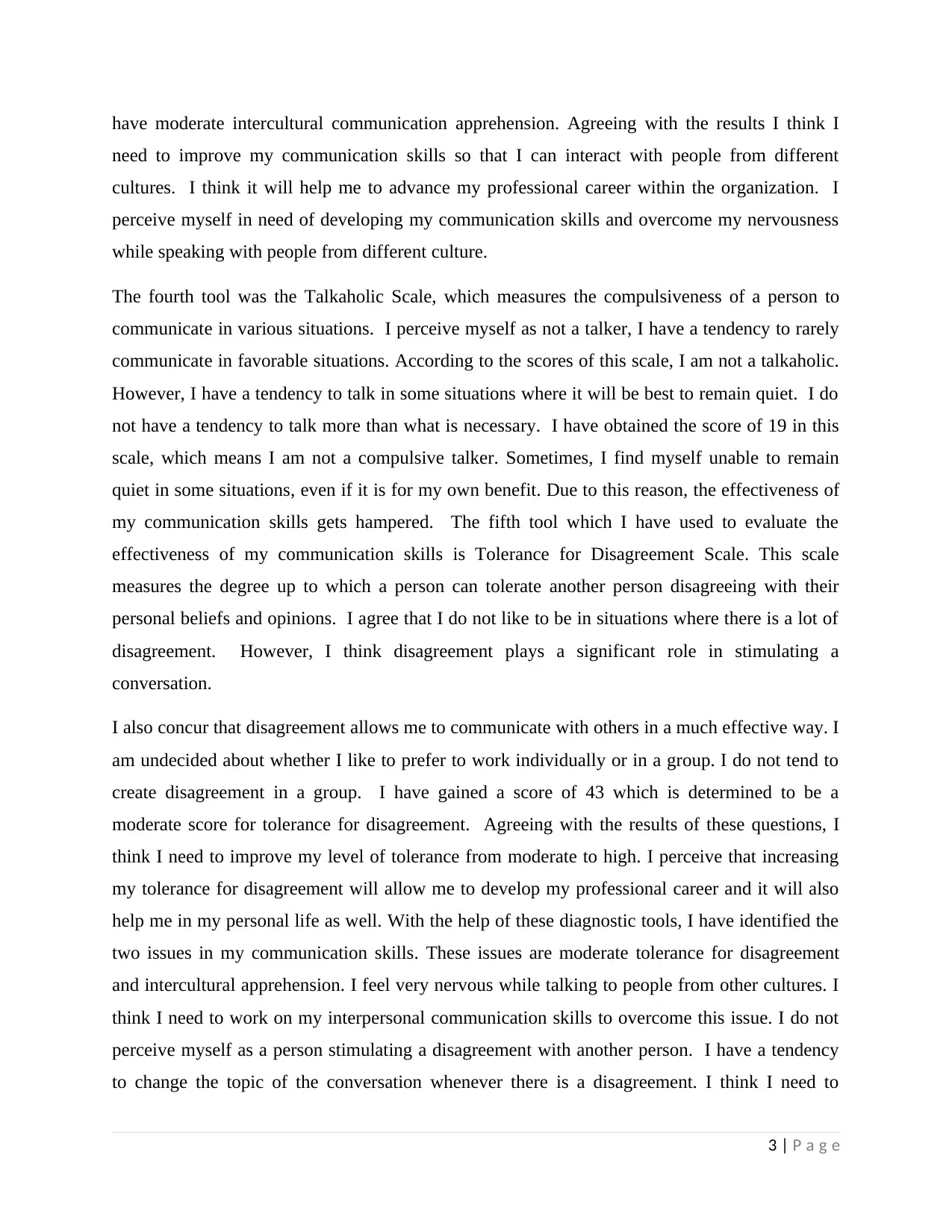
have moderate intercultural communication apprehension. Agreeing with the results I think I
need to improve my communication skills so that I can interact with people from different
cultures. I think it will help me to advance my professional career within the organization. I
perceive myself in need of developing my communication skills and overcome my nervousness
while speaking with people from different culture.
The fourth tool was the Talkaholic Scale, which measures the compulsiveness of a person to
communicate in various situations. I perceive myself as not a talker, I have a tendency to rarely
communicate in favorable situations. According to the scores of this scale, I am not a talkaholic.
However, I have a tendency to talk in some situations where it will be best to remain quiet. I do
not have a tendency to talk more than what is necessary. I have obtained the score of 19 in this
scale, which means I am not a compulsive talker. Sometimes, I find myself unable to remain
quiet in some situations, even if it is for my own benefit. Due to this reason, the effectiveness of
my communication skills gets hampered. The fifth tool which I have used to evaluate the
effectiveness of my communication skills is Tolerance for Disagreement Scale. This scale
measures the degree up to which a person can tolerate another person disagreeing with their
personal beliefs and opinions. I agree that I do not like to be in situations where there is a lot of
disagreement. However, I think disagreement plays a significant role in stimulating a
conversation.
I also concur that disagreement allows me to communicate with others in a much effective way. I
am undecided about whether I like to prefer to work individually or in a group. I do not tend to
create disagreement in a group. I have gained a score of 43 which is determined to be a
moderate score for tolerance for disagreement. Agreeing with the results of these questions, I
think I need to improve my level of tolerance from moderate to high. I perceive that increasing
my tolerance for disagreement will allow me to develop my professional career and it will also
help me in my personal life as well. With the help of these diagnostic tools, I have identified the
two issues in my communication skills. These issues are moderate tolerance for disagreement
and intercultural apprehension. I feel very nervous while talking to people from other cultures. I
think I need to work on my interpersonal communication skills to overcome this issue. I do not
perceive myself as a person stimulating a disagreement with another person. I have a tendency
to change the topic of the conversation whenever there is a disagreement. I think I need to
3 | P a g e
need to improve my communication skills so that I can interact with people from different
cultures. I think it will help me to advance my professional career within the organization. I
perceive myself in need of developing my communication skills and overcome my nervousness
while speaking with people from different culture.
The fourth tool was the Talkaholic Scale, which measures the compulsiveness of a person to
communicate in various situations. I perceive myself as not a talker, I have a tendency to rarely
communicate in favorable situations. According to the scores of this scale, I am not a talkaholic.
However, I have a tendency to talk in some situations where it will be best to remain quiet. I do
not have a tendency to talk more than what is necessary. I have obtained the score of 19 in this
scale, which means I am not a compulsive talker. Sometimes, I find myself unable to remain
quiet in some situations, even if it is for my own benefit. Due to this reason, the effectiveness of
my communication skills gets hampered. The fifth tool which I have used to evaluate the
effectiveness of my communication skills is Tolerance for Disagreement Scale. This scale
measures the degree up to which a person can tolerate another person disagreeing with their
personal beliefs and opinions. I agree that I do not like to be in situations where there is a lot of
disagreement. However, I think disagreement plays a significant role in stimulating a
conversation.
I also concur that disagreement allows me to communicate with others in a much effective way. I
am undecided about whether I like to prefer to work individually or in a group. I do not tend to
create disagreement in a group. I have gained a score of 43 which is determined to be a
moderate score for tolerance for disagreement. Agreeing with the results of these questions, I
think I need to improve my level of tolerance from moderate to high. I perceive that increasing
my tolerance for disagreement will allow me to develop my professional career and it will also
help me in my personal life as well. With the help of these diagnostic tools, I have identified the
two issues in my communication skills. These issues are moderate tolerance for disagreement
and intercultural apprehension. I feel very nervous while talking to people from other cultures. I
think I need to work on my interpersonal communication skills to overcome this issue. I do not
perceive myself as a person stimulating a disagreement with another person. I have a tendency
to change the topic of the conversation whenever there is a disagreement. I think I need to
3 | P a g e
Secure Best Marks with AI Grader
Need help grading? Try our AI Grader for instant feedback on your assignments.
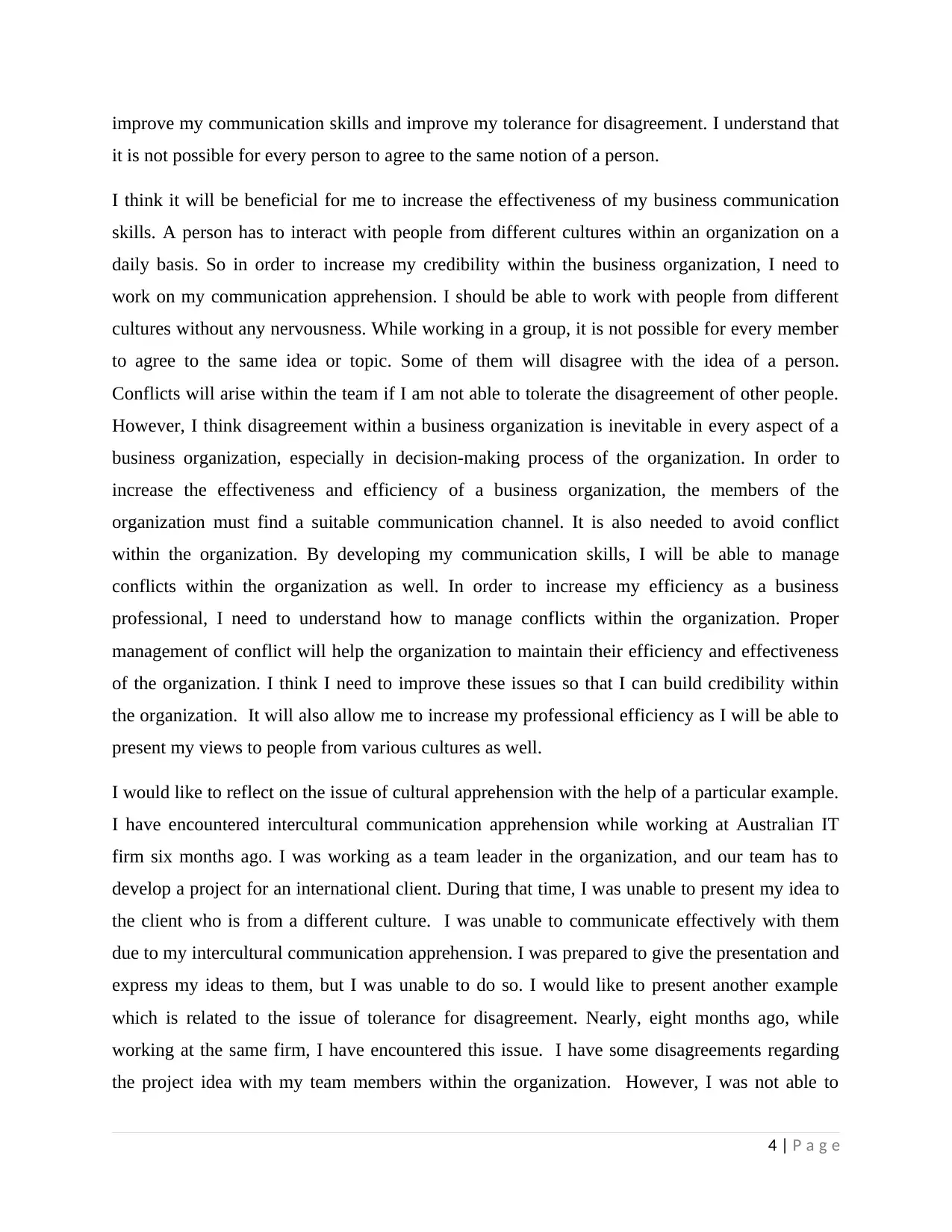
improve my communication skills and improve my tolerance for disagreement. I understand that
it is not possible for every person to agree to the same notion of a person.
I think it will be beneficial for me to increase the effectiveness of my business communication
skills. A person has to interact with people from different cultures within an organization on a
daily basis. So in order to increase my credibility within the business organization, I need to
work on my communication apprehension. I should be able to work with people from different
cultures without any nervousness. While working in a group, it is not possible for every member
to agree to the same idea or topic. Some of them will disagree with the idea of a person.
Conflicts will arise within the team if I am not able to tolerate the disagreement of other people.
However, I think disagreement within a business organization is inevitable in every aspect of a
business organization, especially in decision-making process of the organization. In order to
increase the effectiveness and efficiency of a business organization, the members of the
organization must find a suitable communication channel. It is also needed to avoid conflict
within the organization. By developing my communication skills, I will be able to manage
conflicts within the organization as well. In order to increase my efficiency as a business
professional, I need to understand how to manage conflicts within the organization. Proper
management of conflict will help the organization to maintain their efficiency and effectiveness
of the organization. I think I need to improve these issues so that I can build credibility within
the organization. It will also allow me to increase my professional efficiency as I will be able to
present my views to people from various cultures as well.
I would like to reflect on the issue of cultural apprehension with the help of a particular example.
I have encountered intercultural communication apprehension while working at Australian IT
firm six months ago. I was working as a team leader in the organization, and our team has to
develop a project for an international client. During that time, I was unable to present my idea to
the client who is from a different culture. I was unable to communicate effectively with them
due to my intercultural communication apprehension. I was prepared to give the presentation and
express my ideas to them, but I was unable to do so. I would like to present another example
which is related to the issue of tolerance for disagreement. Nearly, eight months ago, while
working at the same firm, I have encountered this issue. I have some disagreements regarding
the project idea with my team members within the organization. However, I was not able to
4 | P a g e
it is not possible for every person to agree to the same notion of a person.
I think it will be beneficial for me to increase the effectiveness of my business communication
skills. A person has to interact with people from different cultures within an organization on a
daily basis. So in order to increase my credibility within the business organization, I need to
work on my communication apprehension. I should be able to work with people from different
cultures without any nervousness. While working in a group, it is not possible for every member
to agree to the same idea or topic. Some of them will disagree with the idea of a person.
Conflicts will arise within the team if I am not able to tolerate the disagreement of other people.
However, I think disagreement within a business organization is inevitable in every aspect of a
business organization, especially in decision-making process of the organization. In order to
increase the effectiveness and efficiency of a business organization, the members of the
organization must find a suitable communication channel. It is also needed to avoid conflict
within the organization. By developing my communication skills, I will be able to manage
conflicts within the organization as well. In order to increase my efficiency as a business
professional, I need to understand how to manage conflicts within the organization. Proper
management of conflict will help the organization to maintain their efficiency and effectiveness
of the organization. I think I need to improve these issues so that I can build credibility within
the organization. It will also allow me to increase my professional efficiency as I will be able to
present my views to people from various cultures as well.
I would like to reflect on the issue of cultural apprehension with the help of a particular example.
I have encountered intercultural communication apprehension while working at Australian IT
firm six months ago. I was working as a team leader in the organization, and our team has to
develop a project for an international client. During that time, I was unable to present my idea to
the client who is from a different culture. I was unable to communicate effectively with them
due to my intercultural communication apprehension. I was prepared to give the presentation and
express my ideas to them, but I was unable to do so. I would like to present another example
which is related to the issue of tolerance for disagreement. Nearly, eight months ago, while
working at the same firm, I have encountered this issue. I have some disagreements regarding
the project idea with my team members within the organization. However, I was not able to
4 | P a g e
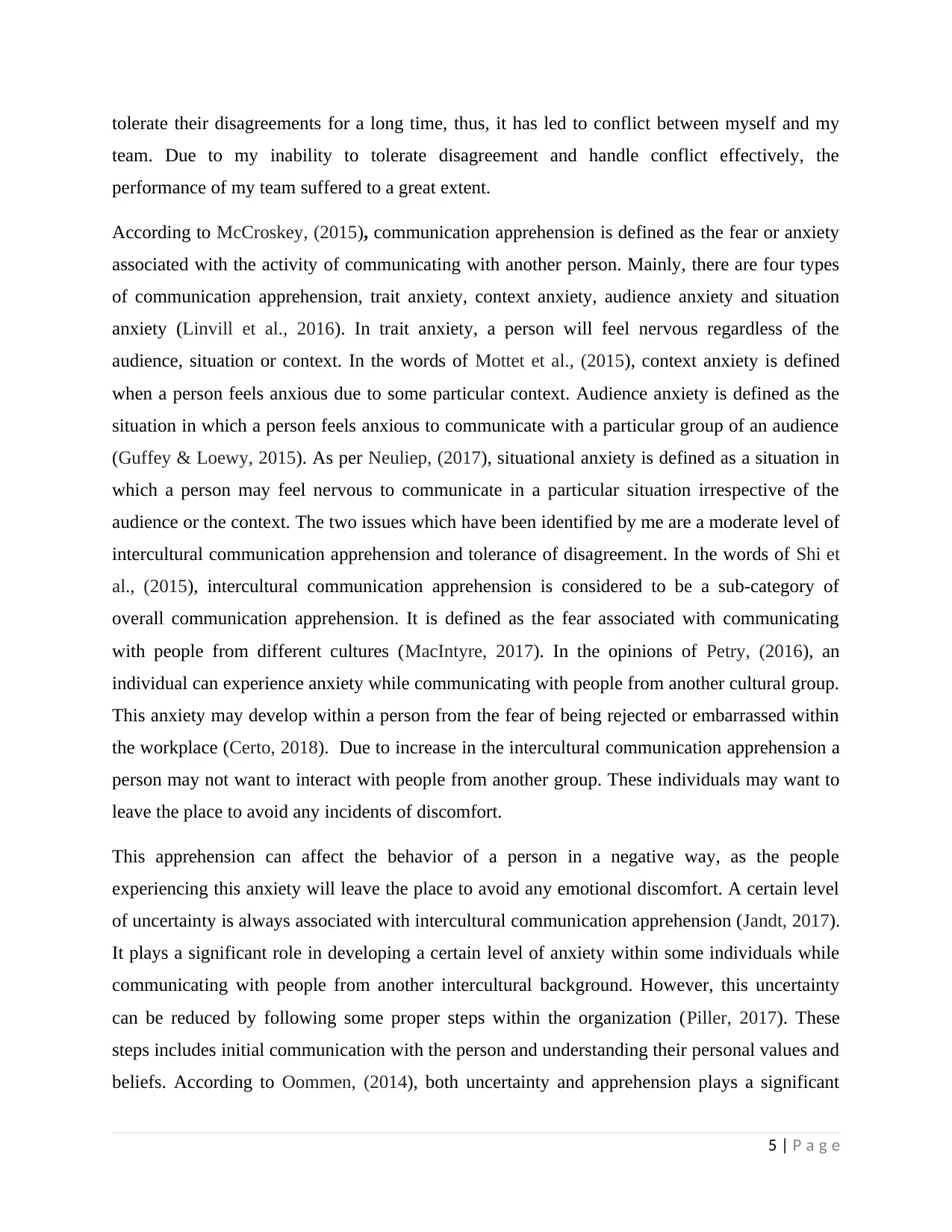
tolerate their disagreements for a long time, thus, it has led to conflict between myself and my
team. Due to my inability to tolerate disagreement and handle conflict effectively, the
performance of my team suffered to a great extent.
According to McCroskey, (2015), communication apprehension is defined as the fear or anxiety
associated with the activity of communicating with another person. Mainly, there are four types
of communication apprehension, trait anxiety, context anxiety, audience anxiety and situation
anxiety (Linvill et al., 2016). In trait anxiety, a person will feel nervous regardless of the
audience, situation or context. In the words of Mottet et al., (2015), context anxiety is defined
when a person feels anxious due to some particular context. Audience anxiety is defined as the
situation in which a person feels anxious to communicate with a particular group of an audience
(Guffey & Loewy, 2015). As per Neuliep, (2017), situational anxiety is defined as a situation in
which a person may feel nervous to communicate in a particular situation irrespective of the
audience or the context. The two issues which have been identified by me are a moderate level of
intercultural communication apprehension and tolerance of disagreement. In the words of Shi et
al., (2015), intercultural communication apprehension is considered to be a sub-category of
overall communication apprehension. It is defined as the fear associated with communicating
with people from different cultures (MacIntyre, 2017). In the opinions of Petry, (2016), an
individual can experience anxiety while communicating with people from another cultural group.
This anxiety may develop within a person from the fear of being rejected or embarrassed within
the workplace (Certo, 2018). Due to increase in the intercultural communication apprehension a
person may not want to interact with people from another group. These individuals may want to
leave the place to avoid any incidents of discomfort.
This apprehension can affect the behavior of a person in a negative way, as the people
experiencing this anxiety will leave the place to avoid any emotional discomfort. A certain level
of uncertainty is always associated with intercultural communication apprehension (Jandt, 2017).
It plays a significant role in developing a certain level of anxiety within some individuals while
communicating with people from another intercultural background. However, this uncertainty
can be reduced by following some proper steps within the organization (Piller, 2017). These
steps includes initial communication with the person and understanding their personal values and
beliefs. According to Oommen, (2014), both uncertainty and apprehension plays a significant
5 | P a g e
team. Due to my inability to tolerate disagreement and handle conflict effectively, the
performance of my team suffered to a great extent.
According to McCroskey, (2015), communication apprehension is defined as the fear or anxiety
associated with the activity of communicating with another person. Mainly, there are four types
of communication apprehension, trait anxiety, context anxiety, audience anxiety and situation
anxiety (Linvill et al., 2016). In trait anxiety, a person will feel nervous regardless of the
audience, situation or context. In the words of Mottet et al., (2015), context anxiety is defined
when a person feels anxious due to some particular context. Audience anxiety is defined as the
situation in which a person feels anxious to communicate with a particular group of an audience
(Guffey & Loewy, 2015). As per Neuliep, (2017), situational anxiety is defined as a situation in
which a person may feel nervous to communicate in a particular situation irrespective of the
audience or the context. The two issues which have been identified by me are a moderate level of
intercultural communication apprehension and tolerance of disagreement. In the words of Shi et
al., (2015), intercultural communication apprehension is considered to be a sub-category of
overall communication apprehension. It is defined as the fear associated with communicating
with people from different cultures (MacIntyre, 2017). In the opinions of Petry, (2016), an
individual can experience anxiety while communicating with people from another cultural group.
This anxiety may develop within a person from the fear of being rejected or embarrassed within
the workplace (Certo, 2018). Due to increase in the intercultural communication apprehension a
person may not want to interact with people from another group. These individuals may want to
leave the place to avoid any incidents of discomfort.
This apprehension can affect the behavior of a person in a negative way, as the people
experiencing this anxiety will leave the place to avoid any emotional discomfort. A certain level
of uncertainty is always associated with intercultural communication apprehension (Jandt, 2017).
It plays a significant role in developing a certain level of anxiety within some individuals while
communicating with people from another intercultural background. However, this uncertainty
can be reduced by following some proper steps within the organization (Piller, 2017). These
steps includes initial communication with the person and understanding their personal values and
beliefs. According to Oommen, (2014), both uncertainty and apprehension plays a significant
5 | P a g e
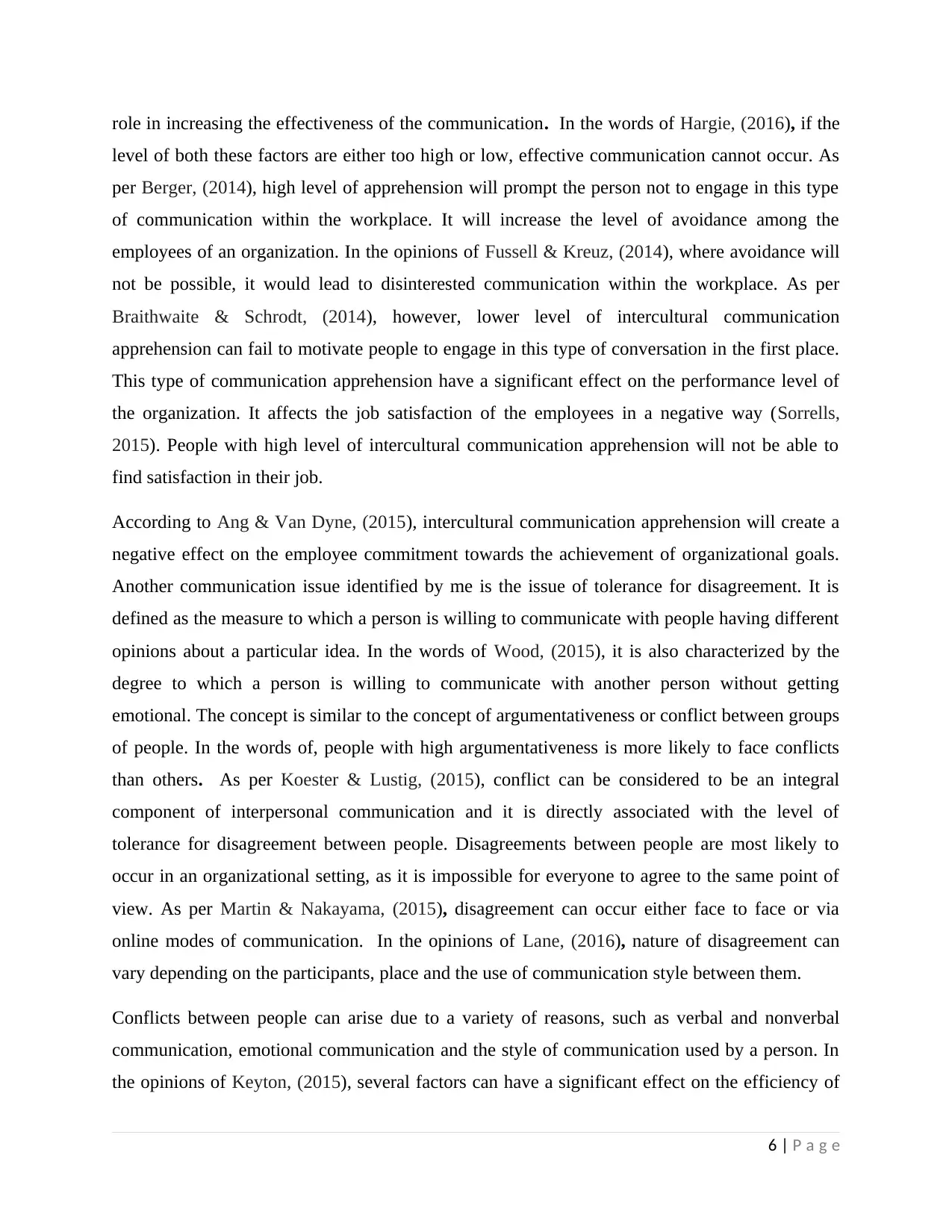
role in increasing the effectiveness of the communication. In the words of Hargie, (2016), if the
level of both these factors are either too high or low, effective communication cannot occur. As
per Berger, (2014), high level of apprehension will prompt the person not to engage in this type
of communication within the workplace. It will increase the level of avoidance among the
employees of an organization. In the opinions of Fussell & Kreuz, (2014), where avoidance will
not be possible, it would lead to disinterested communication within the workplace. As per
Braithwaite & Schrodt, (2014), however, lower level of intercultural communication
apprehension can fail to motivate people to engage in this type of conversation in the first place.
This type of communication apprehension have a significant effect on the performance level of
the organization. It affects the job satisfaction of the employees in a negative way (Sorrells,
2015). People with high level of intercultural communication apprehension will not be able to
find satisfaction in their job.
According to Ang & Van Dyne, (2015), intercultural communication apprehension will create a
negative effect on the employee commitment towards the achievement of organizational goals.
Another communication issue identified by me is the issue of tolerance for disagreement. It is
defined as the measure to which a person is willing to communicate with people having different
opinions about a particular idea. In the words of Wood, (2015), it is also characterized by the
degree to which a person is willing to communicate with another person without getting
emotional. The concept is similar to the concept of argumentativeness or conflict between groups
of people. In the words of, people with high argumentativeness is more likely to face conflicts
than others. As per Koester & Lustig, (2015), conflict can be considered to be an integral
component of interpersonal communication and it is directly associated with the level of
tolerance for disagreement between people. Disagreements between people are most likely to
occur in an organizational setting, as it is impossible for everyone to agree to the same point of
view. As per Martin & Nakayama, (2015), disagreement can occur either face to face or via
online modes of communication. In the opinions of Lane, (2016), nature of disagreement can
vary depending on the participants, place and the use of communication style between them.
Conflicts between people can arise due to a variety of reasons, such as verbal and nonverbal
communication, emotional communication and the style of communication used by a person. In
the opinions of Keyton, (2015), several factors can have a significant effect on the efficiency of
6 | P a g e
level of both these factors are either too high or low, effective communication cannot occur. As
per Berger, (2014), high level of apprehension will prompt the person not to engage in this type
of communication within the workplace. It will increase the level of avoidance among the
employees of an organization. In the opinions of Fussell & Kreuz, (2014), where avoidance will
not be possible, it would lead to disinterested communication within the workplace. As per
Braithwaite & Schrodt, (2014), however, lower level of intercultural communication
apprehension can fail to motivate people to engage in this type of conversation in the first place.
This type of communication apprehension have a significant effect on the performance level of
the organization. It affects the job satisfaction of the employees in a negative way (Sorrells,
2015). People with high level of intercultural communication apprehension will not be able to
find satisfaction in their job.
According to Ang & Van Dyne, (2015), intercultural communication apprehension will create a
negative effect on the employee commitment towards the achievement of organizational goals.
Another communication issue identified by me is the issue of tolerance for disagreement. It is
defined as the measure to which a person is willing to communicate with people having different
opinions about a particular idea. In the words of Wood, (2015), it is also characterized by the
degree to which a person is willing to communicate with another person without getting
emotional. The concept is similar to the concept of argumentativeness or conflict between groups
of people. In the words of, people with high argumentativeness is more likely to face conflicts
than others. As per Koester & Lustig, (2015), conflict can be considered to be an integral
component of interpersonal communication and it is directly associated with the level of
tolerance for disagreement between people. Disagreements between people are most likely to
occur in an organizational setting, as it is impossible for everyone to agree to the same point of
view. As per Martin & Nakayama, (2015), disagreement can occur either face to face or via
online modes of communication. In the opinions of Lane, (2016), nature of disagreement can
vary depending on the participants, place and the use of communication style between them.
Conflicts between people can arise due to a variety of reasons, such as verbal and nonverbal
communication, emotional communication and the style of communication used by a person. In
the opinions of Keyton, (2015), several factors can have a significant effect on the efficiency of
6 | P a g e
Paraphrase This Document
Need a fresh take? Get an instant paraphrase of this document with our AI Paraphraser
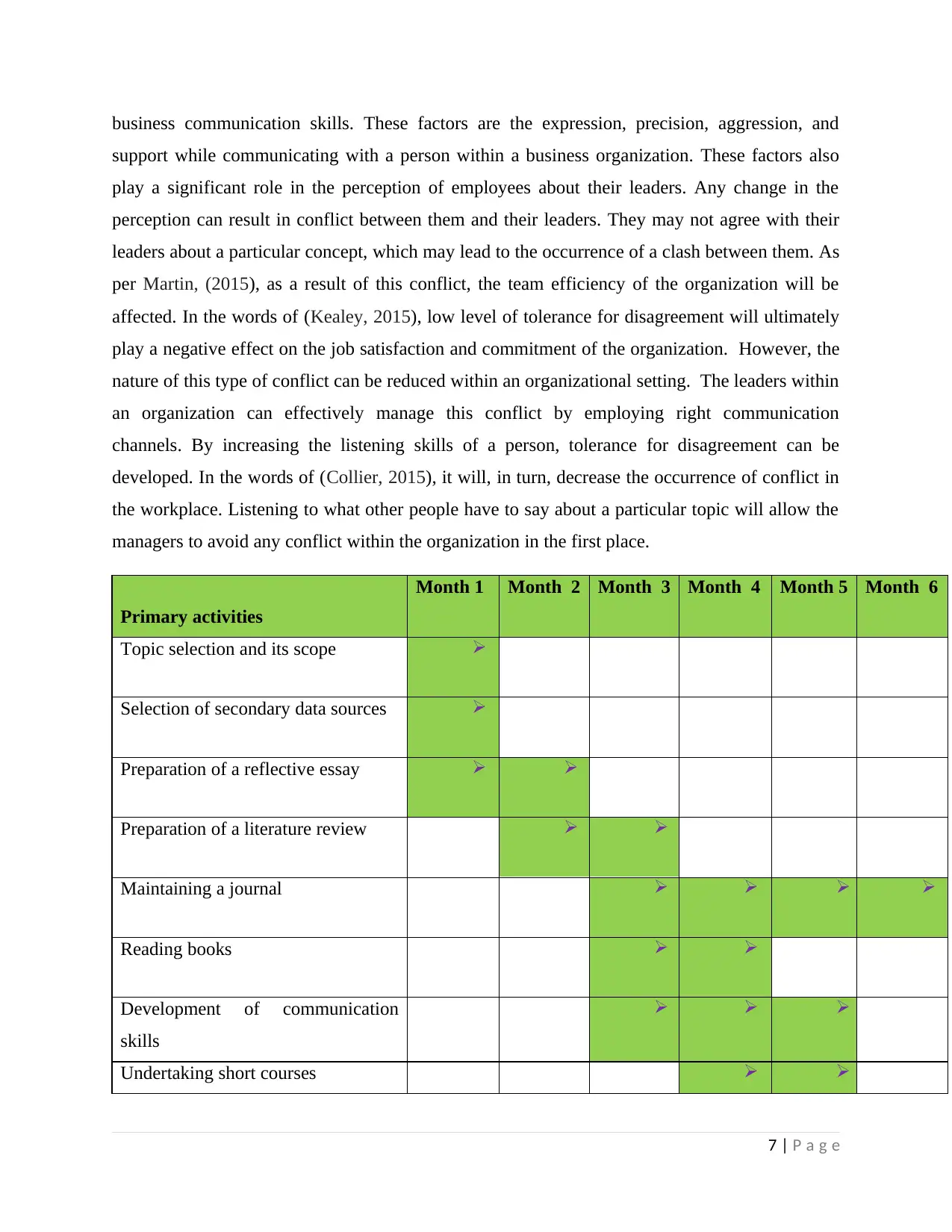
business communication skills. These factors are the expression, precision, aggression, and
support while communicating with a person within a business organization. These factors also
play a significant role in the perception of employees about their leaders. Any change in the
perception can result in conflict between them and their leaders. They may not agree with their
leaders about a particular concept, which may lead to the occurrence of a clash between them. As
per Martin, (2015), as a result of this conflict, the team efficiency of the organization will be
affected. In the words of (Kealey, 2015), low level of tolerance for disagreement will ultimately
play a negative effect on the job satisfaction and commitment of the organization. However, the
nature of this type of conflict can be reduced within an organizational setting. The leaders within
an organization can effectively manage this conflict by employing right communication
channels. By increasing the listening skills of a person, tolerance for disagreement can be
developed. In the words of (Collier, 2015), it will, in turn, decrease the occurrence of conflict in
the workplace. Listening to what other people have to say about a particular topic will allow the
managers to avoid any conflict within the organization in the first place.
Primary activities
Month 1 Month 2 Month 3 Month 4 Month 5 Month 6
Topic selection and its scope
Selection of secondary data sources
Preparation of a reflective essay
Preparation of a literature review
Maintaining a journal
Reading books
Development of communication
skills
Undertaking short courses
7 | P a g e
support while communicating with a person within a business organization. These factors also
play a significant role in the perception of employees about their leaders. Any change in the
perception can result in conflict between them and their leaders. They may not agree with their
leaders about a particular concept, which may lead to the occurrence of a clash between them. As
per Martin, (2015), as a result of this conflict, the team efficiency of the organization will be
affected. In the words of (Kealey, 2015), low level of tolerance for disagreement will ultimately
play a negative effect on the job satisfaction and commitment of the organization. However, the
nature of this type of conflict can be reduced within an organizational setting. The leaders within
an organization can effectively manage this conflict by employing right communication
channels. By increasing the listening skills of a person, tolerance for disagreement can be
developed. In the words of (Collier, 2015), it will, in turn, decrease the occurrence of conflict in
the workplace. Listening to what other people have to say about a particular topic will allow the
managers to avoid any conflict within the organization in the first place.
Primary activities
Month 1 Month 2 Month 3 Month 4 Month 5 Month 6
Topic selection and its scope
Selection of secondary data sources
Preparation of a reflective essay
Preparation of a literature review
Maintaining a journal
Reading books
Development of communication
skills
Undertaking short courses
7 | P a g e
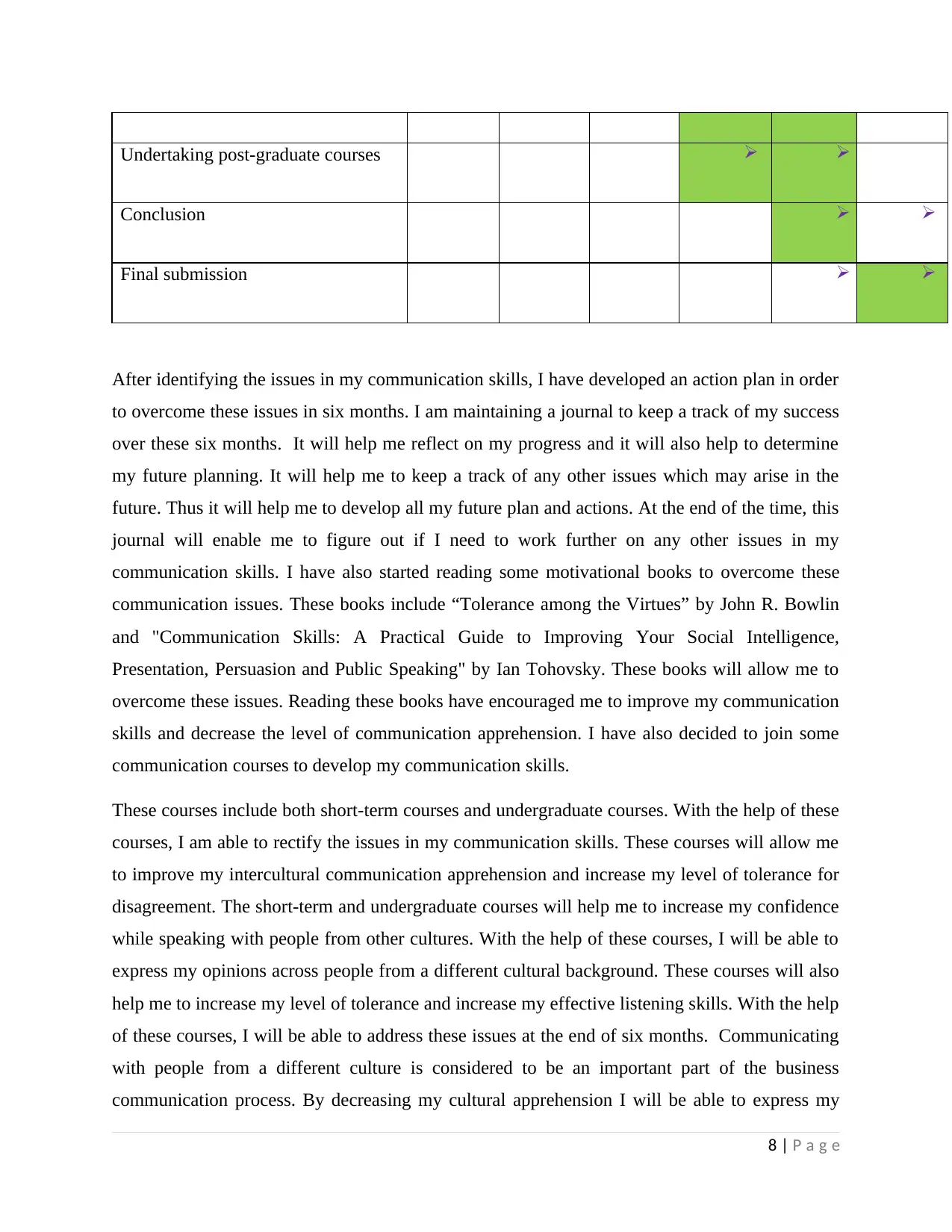
Undertaking post-graduate courses
Conclusion
Final submission
After identifying the issues in my communication skills, I have developed an action plan in order
to overcome these issues in six months. I am maintaining a journal to keep a track of my success
over these six months. It will help me reflect on my progress and it will also help to determine
my future planning. It will help me to keep a track of any other issues which may arise in the
future. Thus it will help me to develop all my future plan and actions. At the end of the time, this
journal will enable me to figure out if I need to work further on any other issues in my
communication skills. I have also started reading some motivational books to overcome these
communication issues. These books include “Tolerance among the Virtues” by John R. Bowlin
and "Communication Skills: A Practical Guide to Improving Your Social Intelligence,
Presentation, Persuasion and Public Speaking" by Ian Tohovsky. These books will allow me to
overcome these issues. Reading these books have encouraged me to improve my communication
skills and decrease the level of communication apprehension. I have also decided to join some
communication courses to develop my communication skills.
These courses include both short-term courses and undergraduate courses. With the help of these
courses, I am able to rectify the issues in my communication skills. These courses will allow me
to improve my intercultural communication apprehension and increase my level of tolerance for
disagreement. The short-term and undergraduate courses will help me to increase my confidence
while speaking with people from other cultures. With the help of these courses, I will be able to
express my opinions across people from a different cultural background. These courses will also
help me to increase my level of tolerance and increase my effective listening skills. With the help
of these courses, I will be able to address these issues at the end of six months. Communicating
with people from a different culture is considered to be an important part of the business
communication process. By decreasing my cultural apprehension I will be able to express my
8 | P a g e
Conclusion
Final submission
After identifying the issues in my communication skills, I have developed an action plan in order
to overcome these issues in six months. I am maintaining a journal to keep a track of my success
over these six months. It will help me reflect on my progress and it will also help to determine
my future planning. It will help me to keep a track of any other issues which may arise in the
future. Thus it will help me to develop all my future plan and actions. At the end of the time, this
journal will enable me to figure out if I need to work further on any other issues in my
communication skills. I have also started reading some motivational books to overcome these
communication issues. These books include “Tolerance among the Virtues” by John R. Bowlin
and "Communication Skills: A Practical Guide to Improving Your Social Intelligence,
Presentation, Persuasion and Public Speaking" by Ian Tohovsky. These books will allow me to
overcome these issues. Reading these books have encouraged me to improve my communication
skills and decrease the level of communication apprehension. I have also decided to join some
communication courses to develop my communication skills.
These courses include both short-term courses and undergraduate courses. With the help of these
courses, I am able to rectify the issues in my communication skills. These courses will allow me
to improve my intercultural communication apprehension and increase my level of tolerance for
disagreement. The short-term and undergraduate courses will help me to increase my confidence
while speaking with people from other cultures. With the help of these courses, I will be able to
express my opinions across people from a different cultural background. These courses will also
help me to increase my level of tolerance and increase my effective listening skills. With the help
of these courses, I will be able to address these issues at the end of six months. Communicating
with people from a different culture is considered to be an important part of the business
communication process. By decreasing my cultural apprehension I will be able to express my
8 | P a g e
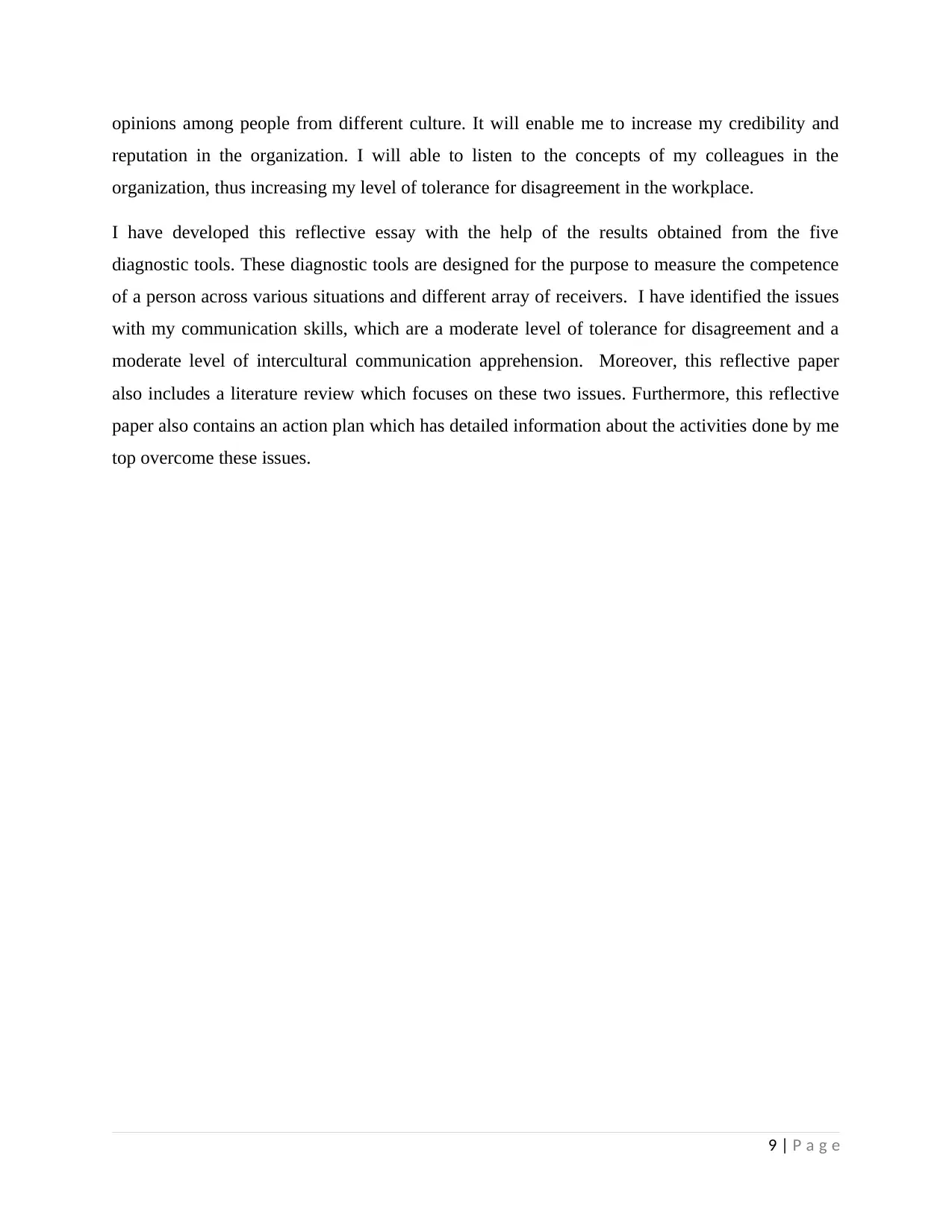
opinions among people from different culture. It will enable me to increase my credibility and
reputation in the organization. I will able to listen to the concepts of my colleagues in the
organization, thus increasing my level of tolerance for disagreement in the workplace.
I have developed this reflective essay with the help of the results obtained from the five
diagnostic tools. These diagnostic tools are designed for the purpose to measure the competence
of a person across various situations and different array of receivers. I have identified the issues
with my communication skills, which are a moderate level of tolerance for disagreement and a
moderate level of intercultural communication apprehension. Moreover, this reflective paper
also includes a literature review which focuses on these two issues. Furthermore, this reflective
paper also contains an action plan which has detailed information about the activities done by me
top overcome these issues.
9 | P a g e
reputation in the organization. I will able to listen to the concepts of my colleagues in the
organization, thus increasing my level of tolerance for disagreement in the workplace.
I have developed this reflective essay with the help of the results obtained from the five
diagnostic tools. These diagnostic tools are designed for the purpose to measure the competence
of a person across various situations and different array of receivers. I have identified the issues
with my communication skills, which are a moderate level of tolerance for disagreement and a
moderate level of intercultural communication apprehension. Moreover, this reflective paper
also includes a literature review which focuses on these two issues. Furthermore, this reflective
paper also contains an action plan which has detailed information about the activities done by me
top overcome these issues.
9 | P a g e
Secure Best Marks with AI Grader
Need help grading? Try our AI Grader for instant feedback on your assignments.
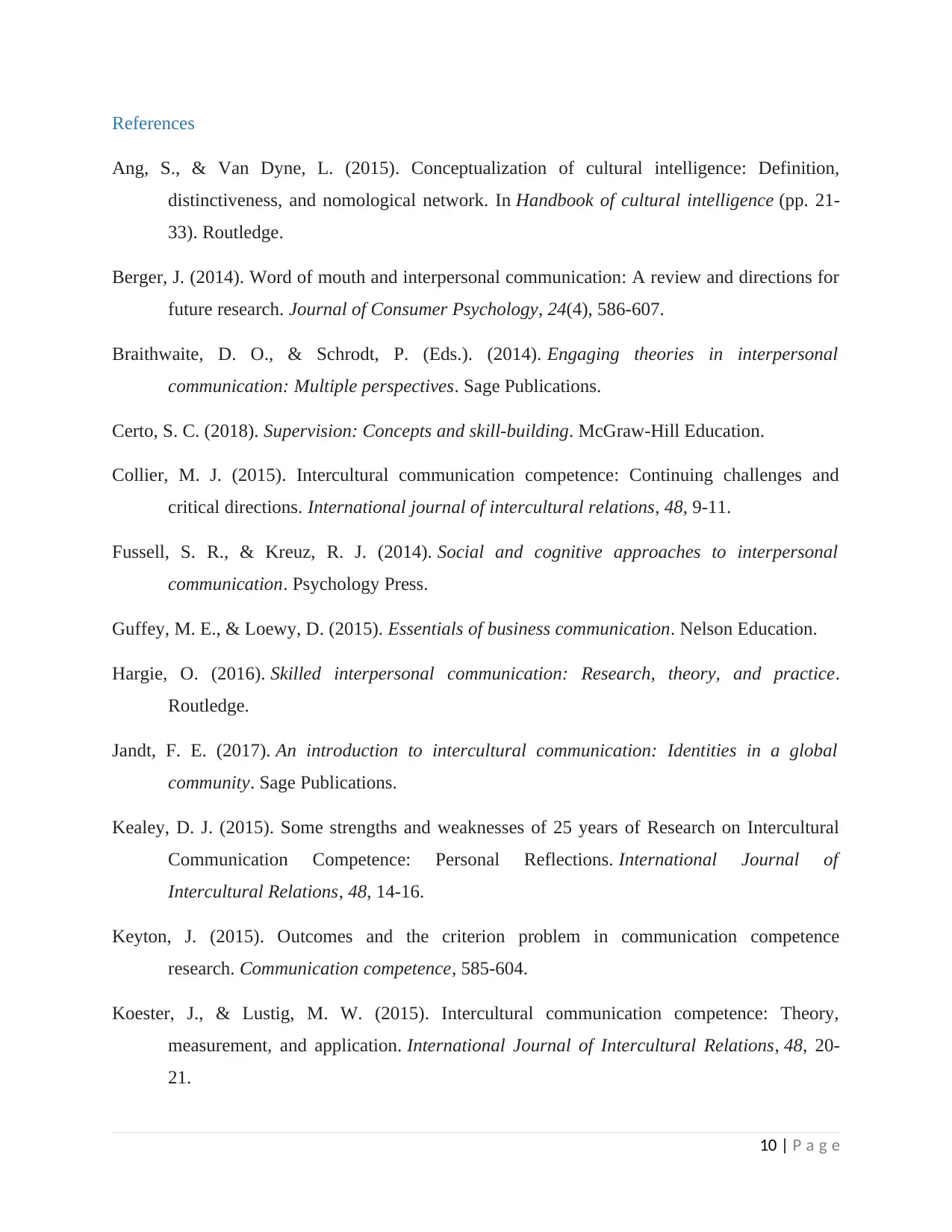
References
Ang, S., & Van Dyne, L. (2015). Conceptualization of cultural intelligence: Definition,
distinctiveness, and nomological network. In Handbook of cultural intelligence (pp. 21-
33). Routledge.
Berger, J. (2014). Word of mouth and interpersonal communication: A review and directions for
future research. Journal of Consumer Psychology, 24(4), 586-607.
Braithwaite, D. O., & Schrodt, P. (Eds.). (2014). Engaging theories in interpersonal
communication: Multiple perspectives. Sage Publications.
Certo, S. C. (2018). Supervision: Concepts and skill-building. McGraw-Hill Education.
Collier, M. J. (2015). Intercultural communication competence: Continuing challenges and
critical directions. International journal of intercultural relations, 48, 9-11.
Fussell, S. R., & Kreuz, R. J. (2014). Social and cognitive approaches to interpersonal
communication. Psychology Press.
Guffey, M. E., & Loewy, D. (2015). Essentials of business communication. Nelson Education.
Hargie, O. (2016). Skilled interpersonal communication: Research, theory, and practice.
Routledge.
Jandt, F. E. (2017). An introduction to intercultural communication: Identities in a global
community. Sage Publications.
Kealey, D. J. (2015). Some strengths and weaknesses of 25 years of Research on Intercultural
Communication Competence: Personal Reflections. International Journal of
Intercultural Relations, 48, 14-16.
Keyton, J. (2015). Outcomes and the criterion problem in communication competence
research. Communication competence, 585-604.
Koester, J., & Lustig, M. W. (2015). Intercultural communication competence: Theory,
measurement, and application. International Journal of Intercultural Relations, 48, 20-
21.
10 | P a g e
Ang, S., & Van Dyne, L. (2015). Conceptualization of cultural intelligence: Definition,
distinctiveness, and nomological network. In Handbook of cultural intelligence (pp. 21-
33). Routledge.
Berger, J. (2014). Word of mouth and interpersonal communication: A review and directions for
future research. Journal of Consumer Psychology, 24(4), 586-607.
Braithwaite, D. O., & Schrodt, P. (Eds.). (2014). Engaging theories in interpersonal
communication: Multiple perspectives. Sage Publications.
Certo, S. C. (2018). Supervision: Concepts and skill-building. McGraw-Hill Education.
Collier, M. J. (2015). Intercultural communication competence: Continuing challenges and
critical directions. International journal of intercultural relations, 48, 9-11.
Fussell, S. R., & Kreuz, R. J. (2014). Social and cognitive approaches to interpersonal
communication. Psychology Press.
Guffey, M. E., & Loewy, D. (2015). Essentials of business communication. Nelson Education.
Hargie, O. (2016). Skilled interpersonal communication: Research, theory, and practice.
Routledge.
Jandt, F. E. (2017). An introduction to intercultural communication: Identities in a global
community. Sage Publications.
Kealey, D. J. (2015). Some strengths and weaknesses of 25 years of Research on Intercultural
Communication Competence: Personal Reflections. International Journal of
Intercultural Relations, 48, 14-16.
Keyton, J. (2015). Outcomes and the criterion problem in communication competence
research. Communication competence, 585-604.
Koester, J., & Lustig, M. W. (2015). Intercultural communication competence: Theory,
measurement, and application. International Journal of Intercultural Relations, 48, 20-
21.
10 | P a g e
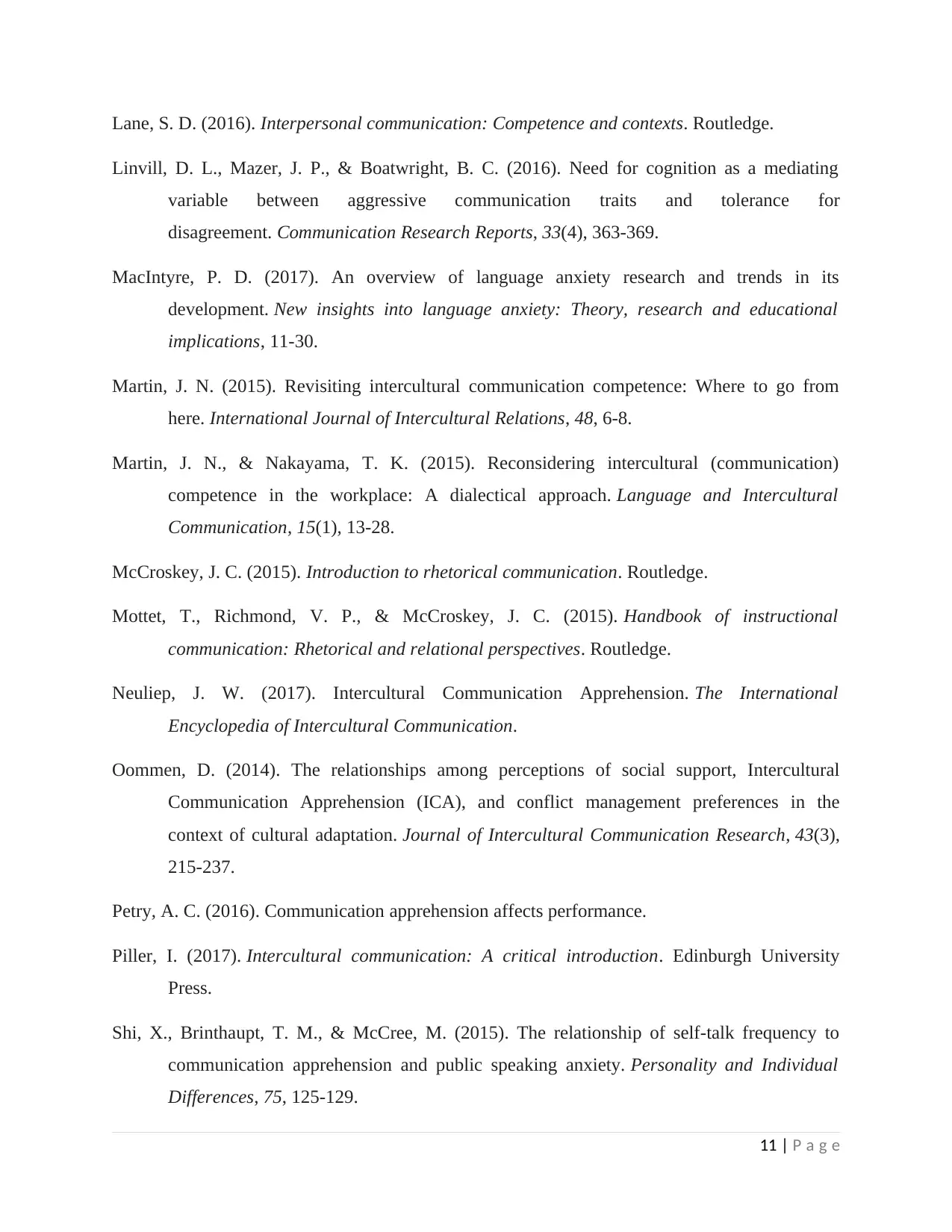
Lane, S. D. (2016). Interpersonal communication: Competence and contexts. Routledge.
Linvill, D. L., Mazer, J. P., & Boatwright, B. C. (2016). Need for cognition as a mediating
variable between aggressive communication traits and tolerance for
disagreement. Communication Research Reports, 33(4), 363-369.
MacIntyre, P. D. (2017). An overview of language anxiety research and trends in its
development. New insights into language anxiety: Theory, research and educational
implications, 11-30.
Martin, J. N. (2015). Revisiting intercultural communication competence: Where to go from
here. International Journal of Intercultural Relations, 48, 6-8.
Martin, J. N., & Nakayama, T. K. (2015). Reconsidering intercultural (communication)
competence in the workplace: A dialectical approach. Language and Intercultural
Communication, 15(1), 13-28.
McCroskey, J. C. (2015). Introduction to rhetorical communication. Routledge.
Mottet, T., Richmond, V. P., & McCroskey, J. C. (2015). Handbook of instructional
communication: Rhetorical and relational perspectives. Routledge.
Neuliep, J. W. (2017). Intercultural Communication Apprehension. The International
Encyclopedia of Intercultural Communication.
Oommen, D. (2014). The relationships among perceptions of social support, Intercultural
Communication Apprehension (ICA), and conflict management preferences in the
context of cultural adaptation. Journal of Intercultural Communication Research, 43(3),
215-237.
Petry, A. C. (2016). Communication apprehension affects performance.
Piller, I. (2017). Intercultural communication: A critical introduction. Edinburgh University
Press.
Shi, X., Brinthaupt, T. M., & McCree, M. (2015). The relationship of self-talk frequency to
communication apprehension and public speaking anxiety. Personality and Individual
Differences, 75, 125-129.
11 | P a g e
Linvill, D. L., Mazer, J. P., & Boatwright, B. C. (2016). Need for cognition as a mediating
variable between aggressive communication traits and tolerance for
disagreement. Communication Research Reports, 33(4), 363-369.
MacIntyre, P. D. (2017). An overview of language anxiety research and trends in its
development. New insights into language anxiety: Theory, research and educational
implications, 11-30.
Martin, J. N. (2015). Revisiting intercultural communication competence: Where to go from
here. International Journal of Intercultural Relations, 48, 6-8.
Martin, J. N., & Nakayama, T. K. (2015). Reconsidering intercultural (communication)
competence in the workplace: A dialectical approach. Language and Intercultural
Communication, 15(1), 13-28.
McCroskey, J. C. (2015). Introduction to rhetorical communication. Routledge.
Mottet, T., Richmond, V. P., & McCroskey, J. C. (2015). Handbook of instructional
communication: Rhetorical and relational perspectives. Routledge.
Neuliep, J. W. (2017). Intercultural Communication Apprehension. The International
Encyclopedia of Intercultural Communication.
Oommen, D. (2014). The relationships among perceptions of social support, Intercultural
Communication Apprehension (ICA), and conflict management preferences in the
context of cultural adaptation. Journal of Intercultural Communication Research, 43(3),
215-237.
Petry, A. C. (2016). Communication apprehension affects performance.
Piller, I. (2017). Intercultural communication: A critical introduction. Edinburgh University
Press.
Shi, X., Brinthaupt, T. M., & McCree, M. (2015). The relationship of self-talk frequency to
communication apprehension and public speaking anxiety. Personality and Individual
Differences, 75, 125-129.
11 | P a g e
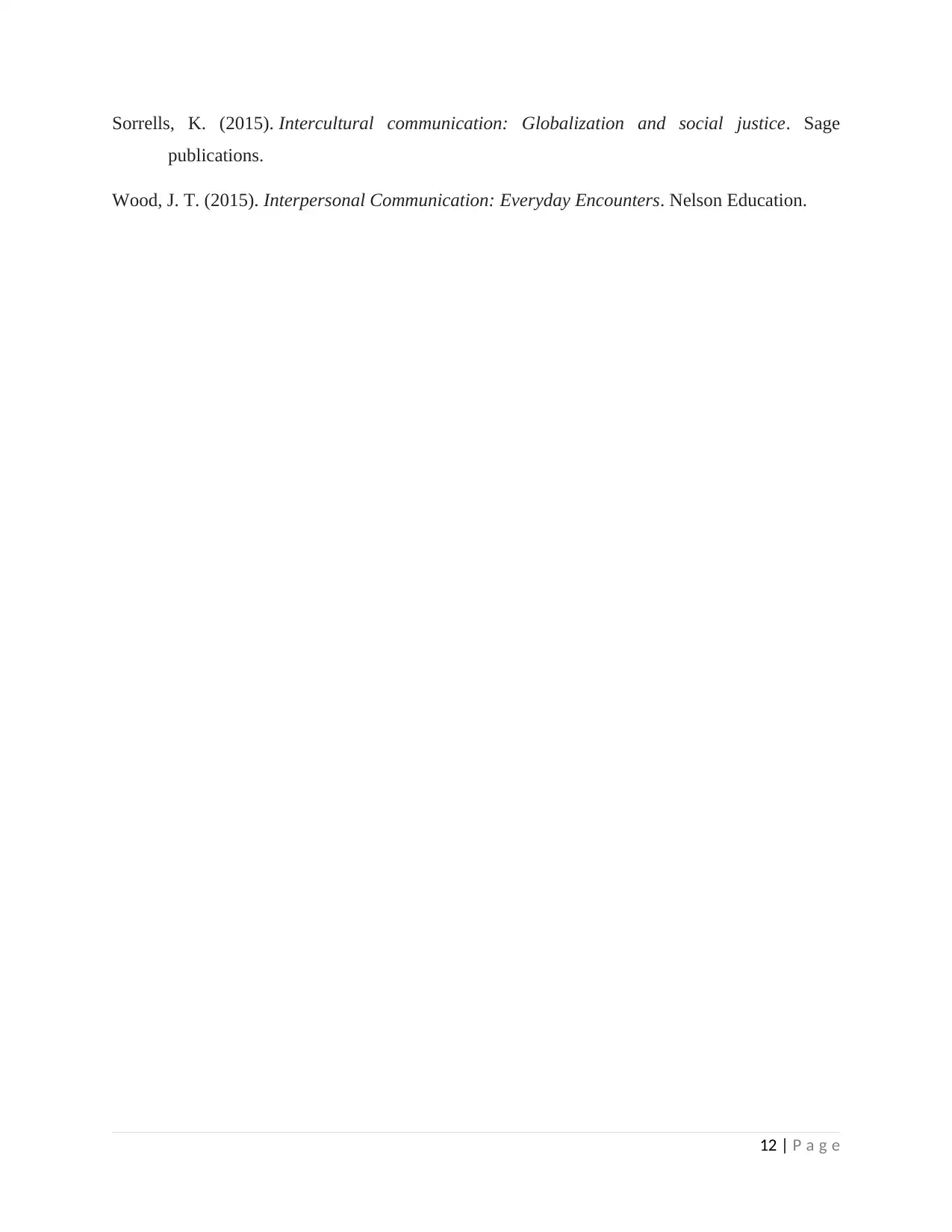
Sorrells, K. (2015). Intercultural communication: Globalization and social justice. Sage
publications.
Wood, J. T. (2015). Interpersonal Communication: Everyday Encounters. Nelson Education.
12 | P a g e
publications.
Wood, J. T. (2015). Interpersonal Communication: Everyday Encounters. Nelson Education.
12 | P a g e
1 out of 13
Your All-in-One AI-Powered Toolkit for Academic Success.
+13062052269
info@desklib.com
Available 24*7 on WhatsApp / Email
![[object Object]](/_next/static/media/star-bottom.7253800d.svg)
Unlock your academic potential
© 2024 | Zucol Services PVT LTD | All rights reserved.

